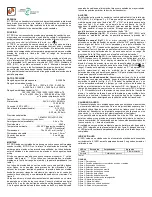
108
MODEL 5081-A
SECTION 15.0
TROUBLESHOOTING
15.7 OzONE MEASUREMENT AND CALIBRATION PROBLEMS
15.7.1 zero current is substantially outside the range -10 to 10 nA.
1. Is the sensor properly wired to the transmitter? See Section 3.0.
2. Is the zero solution ozone free? test the zero solution for ozone level. the concentration should be less than 0.02 ppm.
3. Has adequate time been allowed for the sensor to reach a minimum stable residual current? It may take several hours,
sometimes as long as overnight, for a new sensor to stabilize.
4. Check the membrane for damage and replace it if necessary.
15.7.2 zero reading is unstable.
1. Is the sensor properly wired to the transmitter? See Section 3.0. Verify that all wiring connections are tight.
2. Readings are often erratic when a new or rebuilt sensor is first placed in service. Readings usually stabilize after about
an hour.
3. Is the space between the membrane and cathode filled with electrolyte solution and is the flow path between the elec-
trolyte reservoir and membrane clear? often the flow of electrolyte and be started by simply holding the sensor with
the membrane end pointing down and sharply shaking the sensor a few times as though shaking down a clinical ther-
mometer.
If shaking does not work, try clearing the holes around the cathode stem. Hold the sensor with the membrane end
pointing up. unscrew the membrane retainer and remove the membrane assembly. Be sure the wood ring remains
with the membrane assembly. use the end of a straightened paper clip to clear the holes at the base of the cathode
stem. Replace the membrane.
Verify that the sensor is filled with electrolyte solution. Refer to the sensor instruction manual for details.
15.7.3 Sensor current during calibration is substantially less than 350 nA/ppm at 25°C.
1. Sensor current is a strong function of temperature. the sensor current decreases about 3% for every °C drop in tem-
perature.
2. Sensor current depends on the rate of sample flow past the sensor tip. If the flow is too low, ozone readings will be
low. Refer to the sensor instruction sheet for recommended sample flows.
3. Low current can be caused by lack of electrolyte flow to the cathode and membrane. See step 3 in Section 15.7.2.
4. Is the membrane fouled or coated? A dirty membrane inhibits diffusion of ozone through the membrane, reducing the
sensor current and increasing the response time. Clean the membrane by rinsing it with a stream of water from a wash
bottle or gently wipe the membrane with a soft tissue.
If cleaning the membrane does not improve the sensor response, replace the membrane and electrolyte solution. If
necessary, polish the cathode. See the sensor instruction sheet for details.
Problem
See Section
Zero current is substantially outside the range -10 to 10 nA
15.7.1
Zero reading is unstable
15.7.2
Sensor current during calibration is substantially less than about 350 nA/ppm at 25°C
15.7.3
Process readings are erratic
15.7.4
Readings drift
15.7.5
Sensor does not respond to changes in ozone level
15.7.6
ozone readings are too low
15.7.7















































